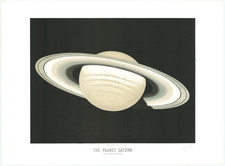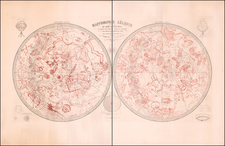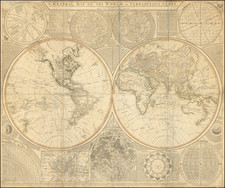Rare Set of Globe Gores – Continuing the Demongenet Tradition of Globes Engraved in Gold and Silver
Nice example of Nicholas Spirinx's set of terrestrial and celestial globe gores, one of the models for globes engraved by gold and silversmiths of the period.
Presented in a set of twelve gores, the geographical content for gores is largely based upon the world maps of Gerard Mercator (1538 and 1541) and Gemma Frisius, particularly his terrestrial globe of 1536. It is quite similar to the work of Francois Demongenet in the 1550s and 1560s.
If constructed, these gores would form a globe roughly 5 inches in diameter. The sea is stippled and includes several ships and intimidating sea monsters. To the south is a giant Terra Australis, with a bulge located roughly where Australia would be found by Europeans in the seventeenth century.
The west coast of North America reflects the knowledge of the region on the eve of the discovery of California. Siponigo (Japan) is shown off the California Coast, with an impressive and unobstructed Northwest Passage shown.
The Eastern part of North America reflects the cartographic knowledge of the region prior to Cartier's discovery of the St. Lawrence River in the late 1530s. The inclusion of Virginia in the middle of the continent reflects a curious addition, albeit one that was necessary in 1610 following the British discoveries and attempts at colonization in the first decade of the 17th Century.
The Demongenet Tradition
Elly Dekker identifies a “Demongenet Tradition” within sixteenth century globe making. In addition to globes made of paper and pasted around spheres, some globes were engraved in metal. These were called manuscript globes and were intended more as luxurious decorations than as geographical aids. Most of the manuscript globes were made by men outside the map trade and followed the geography provided by masters, usually Mercator.
The Demongenet gores, or at least his second set of gores dating from ca. 1560, influenced an entire tradition of manuscript globes. They seem to have gained their geographic information from Gemma Frisius’ 1536 globe, as previously mentioned. Evidence for this includes the phrase Devicta anno 1530 in North America; the phrase reads “Hispania Maior a Nuñno Gusmano devicta anno 1530” on the Frisius globe. Additionally, the particular location and spelling of Japan (derivates of Sipango) originated from Frisius, along with unusual terminology for the tropics.
The avenue by which they reached Demongenet seems to have been Georg Hartmann’s 1547 terrestrial globe gores, which also include the Frisius information and the strange islands near Java of Griforum insulae, or Gryforum insulae as it is included on the Demongenet gores. Demongenet’s gores went on to influence other terrestrial globemakers, including Georg Roll and Johann Reinhold, as well as Nicolas Spirinx.
It is Demongenet’s accompanying celestial gores which cemented his influence with fellow globe makers. Demongenet chose to include only one of the two constellations introduced by Caspar Vopel in 1536; Antinous is on the globe, Coma Berenices is not. A male figure, usually called Acarnar, is positioned at the end of Eridanus. Boötes is shown with his hounds, while a magnitude table is placed near Ursa Major. The sources for these features vary but include Peter Apian (hounds, magnitude table) and Frisius (magnitude table). The male figure at the end of Eridanus and the inclusion of Antinous are largely original choices by Demongenet.
These choices would be copied throughout the sixteenth century. In particular, Acarnar would be depicted as male instead of female as previously shown on celestial globes, including on the 1552 Demongenet gores. The hounds and the magnitude table were already on the 1552 gores. Demongenet’s influential celestial gores would be copied and inspired other globemakers until the mid-seventeenth century in France, Italy, and Germany.
Rarity
The pair of gores is extremely rare.
Shirley located two sets of the globe gores (Newberry Library and Yale).
In 1979, Tony Campbell noted the acquisition of a set of the gores by the British Library in 1979 in Imago Mundi, noting only one other set known.












![Western Hemisphere [and:] Eastern Hemisphere](https://storage.googleapis.com/raremaps/img/small/102187.jpg)

![[Six Star Charts] The Stars, in Six Maps, on the Gnomonic Projection, revised by the Rev. W.R. Dawes. . .](https://storage.googleapis.com/raremaps/img/small/78480.jpg)
![Tabula Geographica Hemisphaerii Borealis ad emenatiora quae adhuc prodieruntexampla jusqu Acad. Reg. Scient. et Eleg. Litt. Boruss. descripta [with:] Tabula Geographica Hemisphaerii Australis...](https://storage.googleapis.com/raremaps/img/small/81806.jpg)
